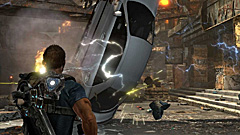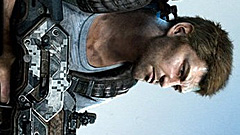June 20, 2012 by Paul Curtin


If you’ve played Gears of War, then you’ve already seen the exact same story that Inversion pawns off as its own. Like in Gears, Inversion deals with a planet similar to Earth that one day is randomly invaded by alien freaks known as Lutadors who somewhat resemble humans and whose language is completely different but still consists of some English words… basically Locust but more generic looking. As the player you’ll assume the role of Davis Russel or Leo Delgado (depending on if playing singleplayer or co-op), who work together as a team fighting the Lutadors and trying to save the world. The only difference between Inversion‘s lead protagonists and Gears‘ Marcus and Dom is that Davis and Leo are ordinary cops instead of juiced up super soldiers and instead of Dom searching for his wife, it’s main character Davis who is searching for his daughter.
Inversion even shares a very similar Gears series of events involving invaders taking over, the heroes escaping from prison, fighting through fallen cities, and going underground via drillpod to take the fight to the invaders on their own home turf. Even the game’s music sounds like a cheap rendition of the original Gears of War score. Despite the stiff and forced voice acting throughout the campaign and during cutscenes, I was still intrigued because of how closely the two stories were to each other, the fact that Inversion doesn’t have to worry about upsetting fanboys allows it more freedom to take chances in its storytelling. I actually found myself playing through the game interested in seeing how Inversion was going to end after being somewhat let down by Epic, who left all the big questions in the Gears franchise basically unanswered even after the third game in the series.
If you manage to make it to the end of Inersion‘s campaign, you’ll be treated to a slight twist that keeps it from totally ripping off the universe created by Epic in their franchise, albeit a completely unrealistic twist that also leaves almost all the big questions unanswered and is more unrealistic than anything done in the Gears franchise. And if you make it to the end of the credits, you’ll see that Saber is hoping to continue the series. But judging by how Inversion turned out, it’s questionable if we’ll end up seeing a sequel and I don’t think many will be demanding one.
There have been a lot of straight up Gears of War cover-and-shoot knockoffs over the years, but Inversion‘s unique use of gravity as a weapon in gameplay is what helps keep the eight-hour campaign interesting. Like Dead Space‘s stasis ability, players can both pick up and drop enemies and objects as big as cars using gravity-manipulating technology. Also like Dead Space‘s zero-G levels, Inversion allows gameplay to completely shift perspectives, letting players float from object to object in areas with low gravity and even fight enemies who may be walking on walls or ceilings while the player is still on the ground. It’s pretty trippy and a lot like Inception‘s city-bending visuals and a shame the technology wasn’t used to tell a more serious story like Nolan’s Inception rather than the Michael Bay-like Gears style that’s already been done better.

Besides being able to pick up and throw any object that isn’t bolted to the ground, the game also features tons of guns, most of which again, are ripped straight from Gears of War. The game’s most common two guns are an automatic rifle with a giant bayonet blade (Retro Lancer) and a burst-fire rifle that can be fired as quickly as the trigger is pulled (Hammer Burst). There are however some more sci-fi weapons that players can retrieve from enemies later on into the game which the Gears series has always been lacking, but for the most part Inversion plays heavily on the idea of using the manipulation of gravity as the player’s main weapon, and Saber has done a good job filling visually-pleasing levels with tons of destructible objects that can be broken down and hurled at enemies or used defensively as cover.
Multiplayer is also a unique experience where the same weapons can be found, and each player is instantly given access to the ability to hit enemies with low gravity and cause them to float in midair and high gravity to knock them down. The idea sounds amazing, and it’s actually pretty fun and a solid online experience. Unfortunately, there’s never anybody online to play against. And when I say never, I mean never. I played Inversion a week after its release due to the craziness of E3 taking priority, and at the time, I could only find one other player to play against. I’ve never seen a game that’s so new have so few people playing it. It’s actually sad because the multiplayer is unique and pretty fun. There are some objective-based modes that make multiplayer more than just about who can hit who first with their gravity powers, but there’s literally nobody online playing them and no offline mode with bots so that they can even be tested.
The Verdict
With a solid story and multiplayer, Inversion is a surprisingly good budget game that should be checked out if you want to get your Gears of War fix and happen to find it heavily discounted. While the game looks good and plays very well, the story ends up being far too generic and with a multiplayer that nobody plays, it’s hard to justify spending full price for a game that half of which can’t be played. The blame can’t fully be put on Saber for so few players being online and playing their decent multiplayer, but then again, if they had made a better game, there would be more players willing to spend some time online and make the overall experience better and help justify its $60 price tag. Inversion isn’t a bad game by any means; it just doesn’t do anything better than any of the games that it borrows heavily from. Inversion gets 2.5 out of 5 stars (Okay).
The Pros
- Enjoyable gravity manipulation gimmick with good physics
- Solid shooter and cover mechanics
- Some areas of the game look really good
- Story is enough to keep you interested
- Multiplayer makes good use of the gravity gimmick
The Cons
- Everything is far too similar to Gears of War
- Nothing that is copied is done better
- The voice acting and delivery is weak
- Nobody plays the competitive multiplayer modes












